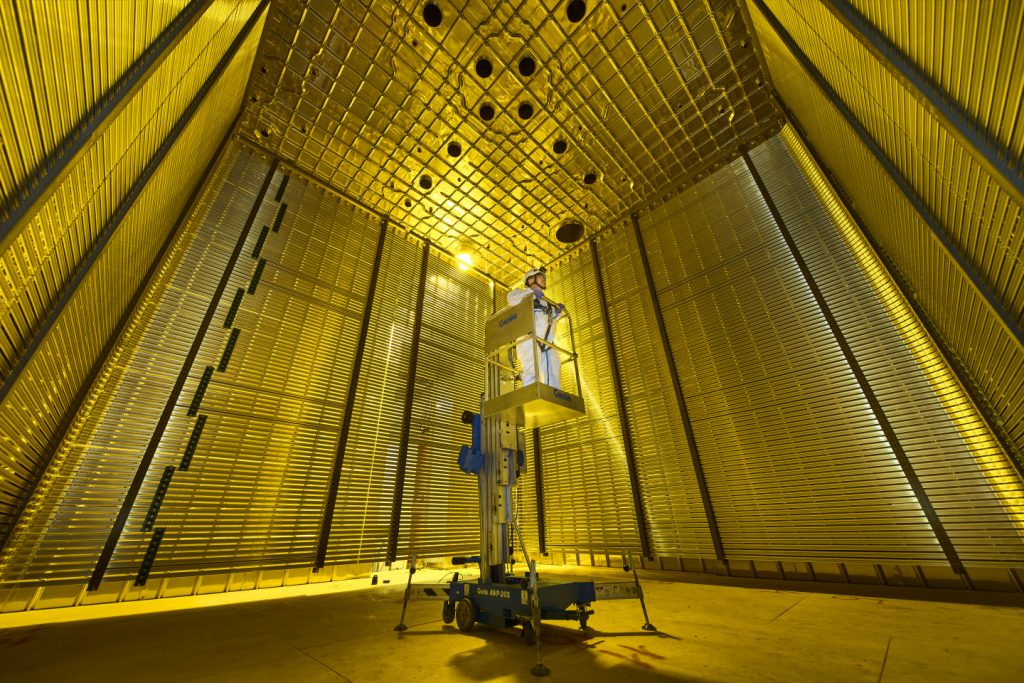The international Deep Underground Neutrino Experiment collaboration, hosted by the U.S. Department of Energy’s Fermilab, continues to grow. During the collaboration meeting at Fermilab from May 14-18, the DUNE Institutional Board admitted two new institutions to the collaboration: the Laboratory of Instrumentation and Experimental Particle Physics, which is the first institution from Portugal to join DUNE, and the University of Bucharest, the second institution from Romania. The collaboration now comprises 1,061 scientists from 175 institutions in 32 countries.
“The DUNE collaboration is growing at a rate of about 100 people per year,” said co-spokesperson Stefan Soldner-Rembold, professor at the University of Manchester in the UK. “About 60 percent of the 175 institutions on DUNE are from outside the United States.”
A substantial portion of the collaboration meeting was devoted to the upcoming operation of two DUNE prototype detectors at the European research center CERN, known as ProtoDUNE, with speakers presenting the updates on the construction happening this spring.
“There has been really remarkable progress,” said DUNE co-spokesperson Ed Blucher, professor at the University of Chicago. “Congratulations to the installation teams at CERN for their incredible efforts on the two ProtoDUNE detectors. Both are on track to collect data that will be important for finalizing the specifications of the liquid-argon detectors for the DUNE experiment.”
In addition to hosting the construction of the prototype detectors, CERN also will provide the cryostat for the first DUNE detector module to be installed at the Sanford Underground Research Laboratory in South Dakota, housed by the Long-Baseline Neutrino Facility that will be constructed at Fermilab and Sanford Lab.
“ProtoDUNE is a fundamental step towards many technological aspects of LBNF/DUNE,” said Marzio Nessi, leader of the CERN Neutrino Platform. “Before embarking on a multikiloton liquid-argon detector about 1.5 kilometers underground at Sanford Lab, we have to prove at the kiloton scale that we master the construction and operation of the large modular cryostats, that we are able to obtain the required purity of the liquid argon, and that we are able to keep the high-voltage electric field inside the detector at the nominal value, without discharges. ProtoDUNE is the first step, which will give us confidence that we are on the right track.”
Filling of the first prototype detector at CERN with liquid argon, known as single-phase ProtoDUNE detector, is anticipated to begin in June.
“Completion of the huge protoDUNE detector in little over two years from approval is an extraordinary achievement by groups on both sides of the Atlantic,” said ProtoDUNE co-leader Christos Touramanis, professor at the University of Liverpool in the UK. “It fills us with confidence that the ambitious DUNE construction schedule will be met.”
The first ProtoDUNE detector will start recording particle tracks later this year.
“It has been an incredible team effort bringing together the ProtoDUNE detector elements constructed in the U.S. and UK,” said ProtoDUNE Construction Coordinator Regina Rameika of Fermilab. “The support we have received from CERN for the installation has been amazing. We are now looking forward to operating the detector.”
The construction of the second prototype detector at CERN, known as the dual-phase ProtoDUNE detector, also is progressing well.
“In the last months, the progress in the construction and test of the various components of the second DUNE prototype detector at CERN has changed gear,” said Filippo Resnati, the technical coordinator of the Neutrino Platform at CERN. “The field cage is fully installed and has been tested at 150,000 volts. In June, the first 3-meter-by-3-meter signal-amplification system will be ready to be extensively tested in realistic thermodynamic conditions. Light readout, electronics, data acquisition and detector control systems are in very good shape too. The installation of the detector will be completed in fall of this year.”
Once it is operational, scientists will record cosmic-ray muons to test the detector.
“We are eagerly looking forward to the completion and the operation of the dual-phase ProtoDUNE detector,” said CNRS Research DIrector Dario Autiero of the French National Institute of Nuclear and Particle Physics. “The innovative design of this prototype is the outcome of a long R&D process. It is aimed at providing DUNE additional handles. The construction effort for this large-scale detector required a strong dedication from many groups and would not have been possible without the fundamental support from CERN.”
Another important topic at the collaboration meeting was the Interim Design Report for the construction of DUNE far detector modules in South Dakota. The document is based on the experience DUNE scientists and engineers gained during the design and construction of the prototype detectors at CERN. It is a step toward the publication of the more detailed Technical Design Report in 2019, which will serve as the blueprint for the construction of the first DUNE far detector modules.
“Within a few months, the recently formed DUNE Far Detector Institutional Consortia — who take responsibility for the construction, installation and commissioning of the different far detector subsystems — were able to provide detailed documentation on the current state of their planning efforts,” said Eric James, DUNE technical coordinator. “Production of the Interim Design Report on such a short time scale sends a strong signal that the collaboration remains on track to meet its goal of producing the Technical Design Reports for the first two far detector modules by spring 2019.”
DUNE now comprises institutions from 32 countries: Armenia, Brazil, Bulgaria, Canada, Chile, China, Colombia, Czech Republic, Finland, France, Greece, India, Iran, Italy, Japan, Madagascar, Mexico, Netherlands, Paraguay, Peru, Poland, Portugal, Romania, Russia, South Korea, Spain, Sweden, Switzerland, Turkey, Ukraine, United Kingdom, and United States. More information is at dunescience.org.
To learn more about the Deep Underground Neutrino Experiment, the Long-Baseline Neutrino Facility that will house the experiment, and the PIP-II particle accelerator project that will power the neutrino beam for the experiment, visit www.fnal.gov/pub/science/lbnf-dune/.





